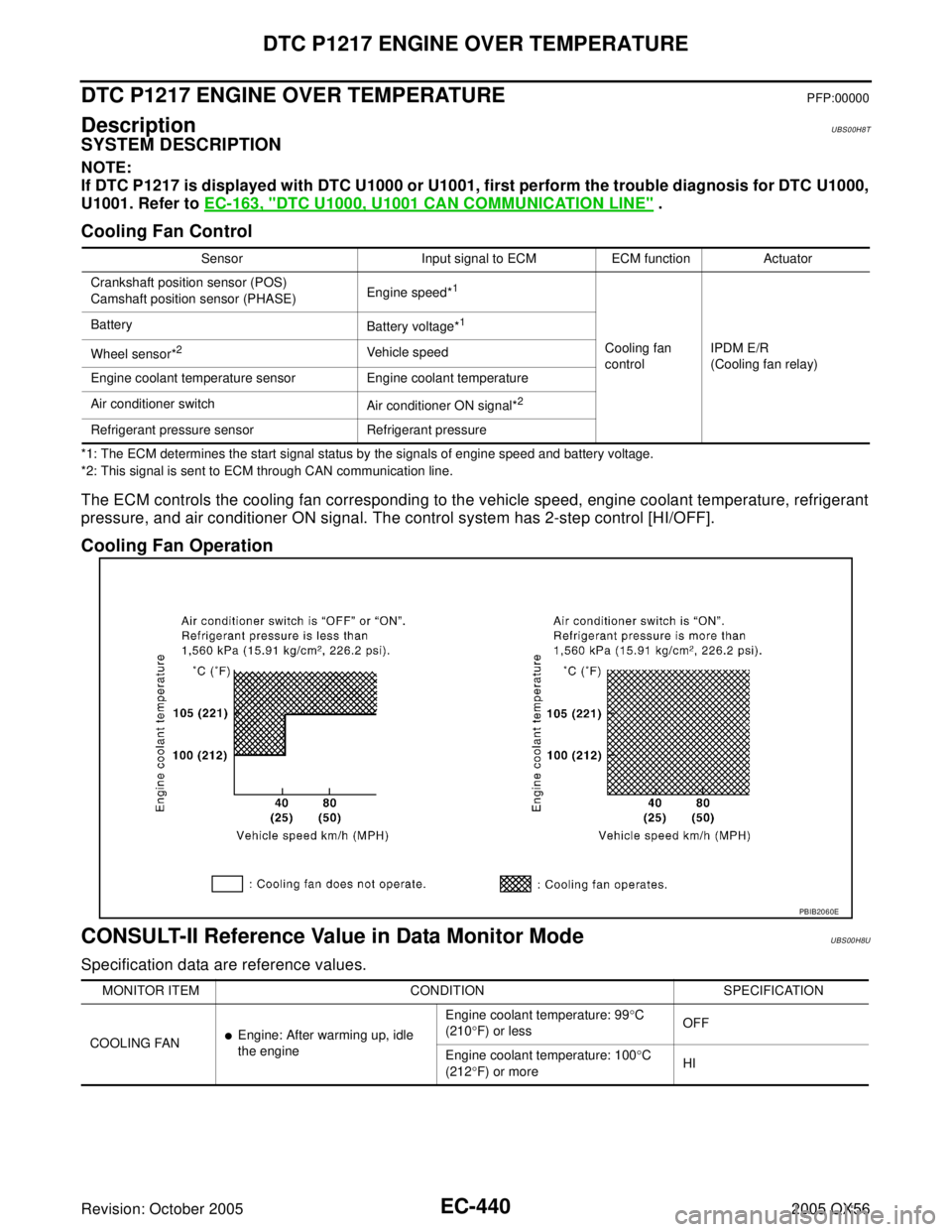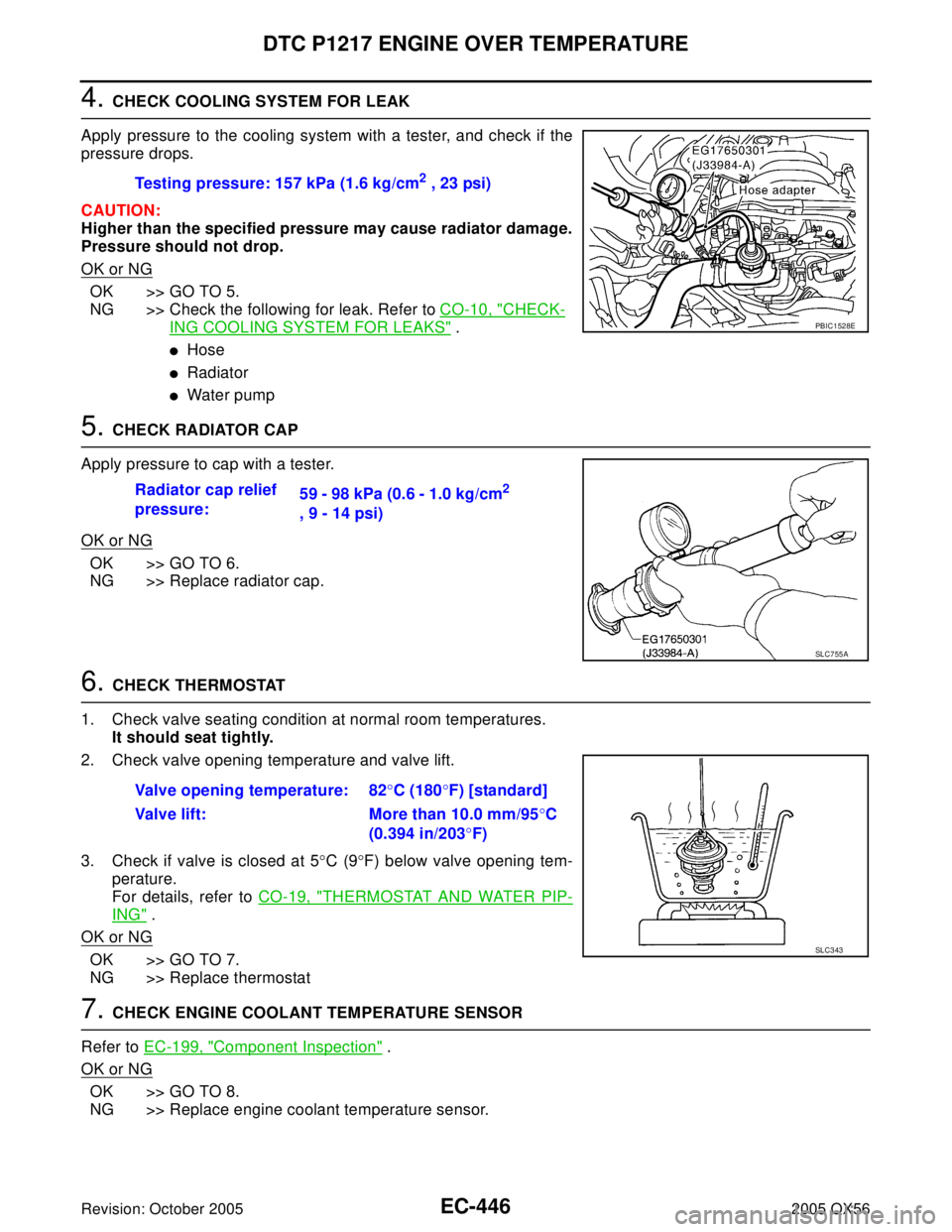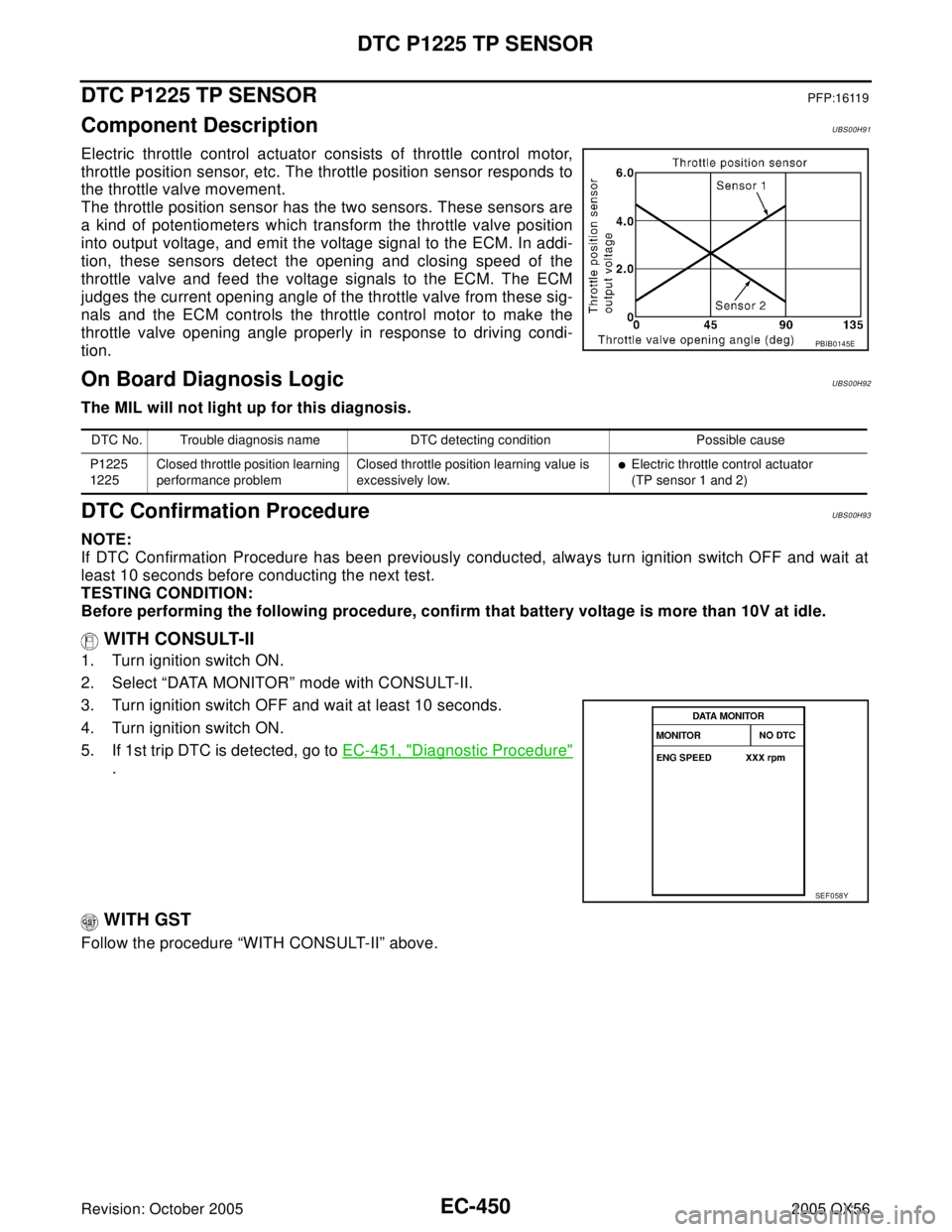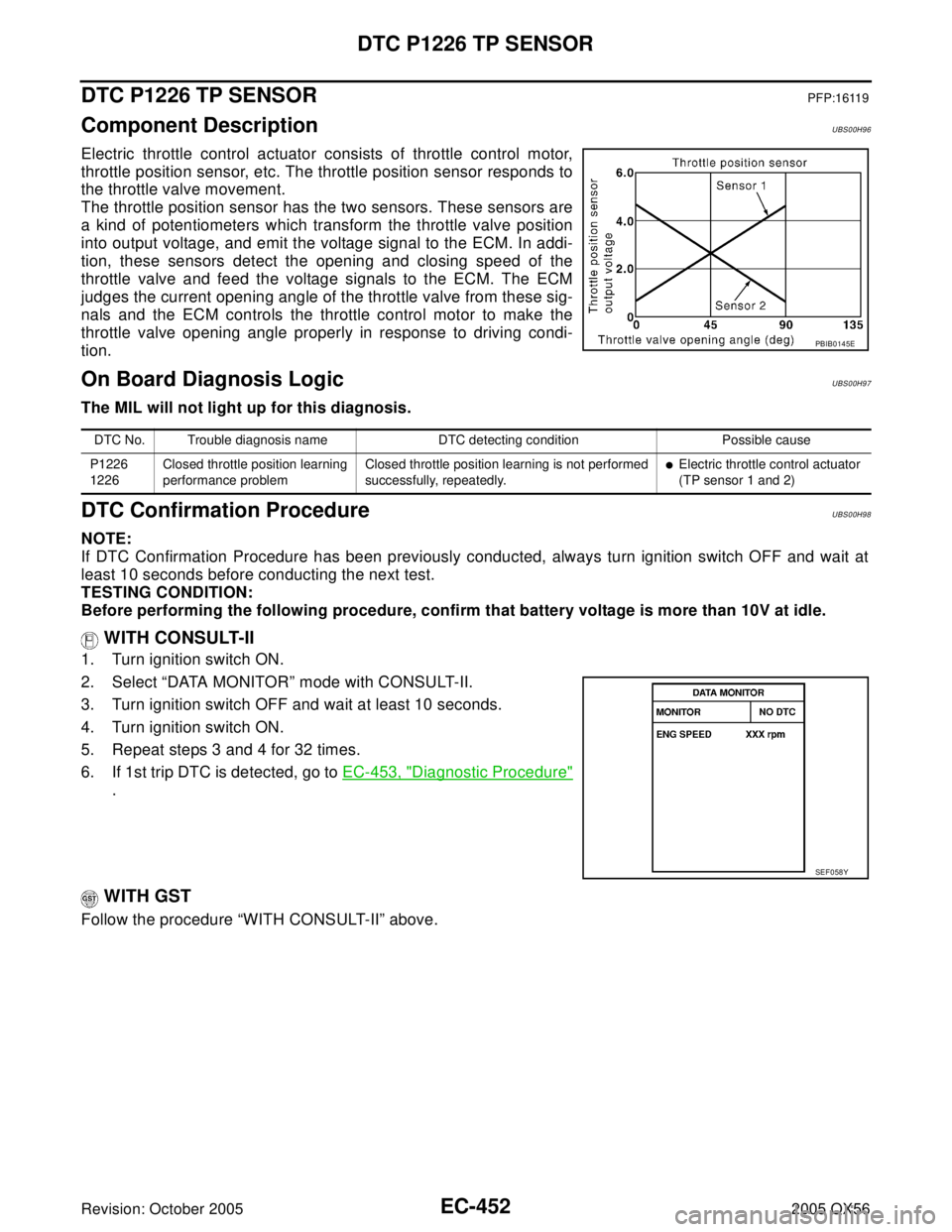Page 1631 of 3419

EC-440Revision: October 2005
DTC P1217 ENGINE OVER TEMPERATURE
2005 QX56
DTC P1217 ENGINE OVER TEMPERATUREPFP:00000
DescriptionUBS00H8T
SYSTEM DESCRIPTION
NOTE:
If DTC P1217 is displayed with DTC U1000 or U1001, first perform the trouble diagnosis for DTC U1000,
U1001. Refer to EC-163, "
DTC U1000, U1001 CAN COMMUNICATION LINE" .
Cooling Fan Control
*1: The ECM determines the start signal status by the signals of engine speed and battery voltage.
*2: This signal is sent to ECM through CAN communication line.
The ECM controls the cooling fan corresponding to the vehicle speed, engine coolant temperature, refrigerant
pressure, and air conditioner ON signal. The control system has 2-step control [HI/OFF].
Cooling Fan Operation
CONSULT-II Reference Value in Data Monitor ModeUBS00H8U
Specification data are reference values.
Sensor Input signal to ECM ECM function Actuator
Crankshaft position sensor (POS)
Camshaft position sensor (PHASE)Engine speed*
1
Cooling fan
controlIPDM E/R
(Cooling fan relay) Battery
Battery voltage*
1
Wheel sensor*2Vehicle speed
Engine coolant temperature sensor Engine coolant temperature
Air conditioner switch
Air conditioner ON signal*
2
Refrigerant pressure sensor Refrigerant pressure
PBIB2060E
MONITOR ITEM CONDITION SPECIFICATION
COOLING FAN
�Engine: After warming up, idle
the engineEngine coolant temperature: 99°C
(210°F) or lessOFF
Engine coolant temperature: 100°C
(212°F) or moreHI
Page 1633 of 3419
EC-442Revision: October 2005
DTC P1217 ENGINE OVER TEMPERATURE
2005 QX56
4. Perform “COOLING FAN” in “ACTIVE TEST” mode with CON-
SULT-II.
5. If the results are NG, go to EC-445, "
Diagnostic Procedure" .
WITH GST
1. Check the coolant level in the reservoir tank and radiator.
Allow engine to cool before checking coolant level.
If the coolant level in the reservoir tank and/or radiator is below
the proper range, skip the following steps and go to EC-445,
"Diagnostic Procedure" .
2. Confirm whether customer filled the coolant or not. If customer
filled the coolant, skip the following steps and go to EC-445,
"Diagnostic Procedure" .
3. Disconnect engine coolant temperature sensor harness connec-
tor.
4. Connect 150Ω resistor to engine coolant temperature sensor
harness connector.
5. Start engine and make sure that cooling fan operates.
CAUTION:
Be careful not to overheat engine.
6. If NG, go to EC-445, "
Diagnostic Procedure" .
SEF 6 46 X
SEF 6 21 W
SEF 8 82 V
Page 1636 of 3419
DTC P1217 ENGINE OVER TEMPERATURE
EC-445
C
D
E
F
G
H
I
J
K
L
MA
EC
Revision: October 20052005 QX56
Diagnostic ProcedureUBS00H8Y
1. INSPECTION START
Do you have CONSULT-II?
Ye s o r N o
Yes >> GO TO 2.
No >> GO TO 3.
2. CHECK COOLING FAN MOTOR OPERATION
With CONSULT-II
1. Start engine and let it idle.
2. Select “COOLING FAN” in “ACTIVE TEST” mode with CON-
SULT-II.
3. Make sure that cooling fan operates.
OK or NG
OK >> GO TO 4.
NG >> Check cooling fan control circuit. (Go to EC-447, "
PRO-
CEDURE A" .)
3. CHECK COOLING FAN MOTOR OPERATION
Without CONSULT-II
1. Disconnect engine coolant temperature sensor harness connector.
2. Connect 150Ω resistor to engine coolant temperature sensor harness connector.
3. Start engine and let it idle.
4. Make sure that cooling fan operates.
OK or NG
OK >> GO TO 4.
NG >> Check cooling fan control circuit. (Go to EC-447, "
PRO-
CEDURE A" .)
SEF 6 46 X
SEF 8 82 V
Page 1637 of 3419

EC-446Revision: October 2005
DTC P1217 ENGINE OVER TEMPERATURE
2005 QX56
4. CHECK COOLING SYSTEM FOR LEAK
Apply pressure to the cooling system with a tester, and check if the
pressure drops.
CAUTION:
Higher than the specified pressure may cause radiator damage.
Pressure should not drop.
OK or NG
OK >> GO TO 5.
NG >> Check the following for leak. Refer to CO-10, "
CHECK-
ING COOLING SYSTEM FOR LEAKS" .
�Hose
�Radiator
�Wate r p ump
5. CHECK RADIATOR CAP
Apply pressure to cap with a tester.
OK or NG
OK >> GO TO 6.
NG >> Replace radiator cap.
6. CHECK THERMOSTAT
1. Check valve seating condition at normal room temperatures.
It should seat tightly.
2. Check valve opening temperature and valve lift.
3. Check if valve is closed at 5°C (9°F) below valve opening tem-
perature.
For details, refer to CO-19, "
THERMOSTAT AND WATER PIP-
ING" .
OK or NG
OK >> GO TO 7.
NG >> Replace thermostat
7. CHECK ENGINE COOLANT TEMPERATURE SENSOR
Refer to EC-199, "
Component Inspection" .
OK or NG
OK >> GO TO 8.
NG >> Replace engine coolant temperature sensor.Testing pressure: 157 kPa (1.6 kg/cm
2 , 23 psi)
PBIC1528E
Radiator cap relief
pressure:59 - 98 kPa (0.6 - 1.0 kg/cm2
, 9 - 14 psi)
SL C7 55 A
Valve opening temperature: 82°C (180°F) [standard]
Valve lift: More than 10.0 mm/95°C
(0.394 in/203°F)
SL C3 43
Page 1641 of 3419

EC-450Revision: October 2005
DTC P1225 TP SENSOR
2005 QX56
DTC P1225 TP SENSORPFP:16119
Component DescriptionUBS00H91
Electric throttle control actuator consists of throttle control motor,
throttle position sensor, etc. The throttle position sensor responds to
the throttle valve movement.
The throttle position sensor has the two sensors. These sensors are
a kind of potentiometers which transform the throttle valve position
into output voltage, and emit the voltage signal to the ECM. In addi-
tion, these sensors detect the opening and closing speed of the
throttle valve and feed the voltage signals to the ECM. The ECM
judges the current opening angle of the throttle valve from these sig-
nals and the ECM controls the throttle control motor to make the
throttle valve opening angle properly in response to driving condi-
tion.
On Board Diagnosis LogicUBS00H92
The MIL will not light up for this diagnosis.
DTC Confirmation ProcedureUBS00H93
NOTE:
If DTC Confirmation Procedure has been previously conducted, always turn ignition switch OFF and wait at
least 10 seconds before conducting the next test.
TESTING CONDITION:
Before performing the following procedure, confirm that battery voltage is more than 10V at idle.
WITH CONSULT-II
1. Turn ignition switch ON.
2. Select “DATA MONITOR” mode with CONSULT-II.
3. Turn ignition switch OFF and wait at least 10 seconds.
4. Turn ignition switch ON.
5. If 1st trip DTC is detected, go to EC-451, "
Diagnostic Procedure"
.
WITH GST
Follow the procedure “WITH CONSULT-II” above.
PBIB0145E
DTC No. Trouble diagnosis name DTC detecting condition Possible cause
P1225
1225Closed throttle position learning
performance problemClosed throttle position learning value is
excessively low.
�Electric throttle control actuator
(TP sensor 1 and 2)
SEF 0 58 Y
Page 1642 of 3419
DTC P1225 TP SENSOR
EC-451
C
D
E
F
G
H
I
J
K
L
MA
EC
Revision: October 20052005 QX56
Diagnostic ProcedureUBS00H94
1. CHECK ELECTRIC THROTTLE CONTROL ACTUATOR VISUALLY
1. Turn ignition switch OFF.
2. Remove the intake air duct.
3. Check if foreign matter is caught between the throttle valve and
the housing.
OK or NG
OK >> GO TO 2.
NG >> Remove the foreign matter and clean the electric throttle
control actuator inside.
2. REPLACE ELECTRIC THROTTLE CONTROL ACTUATOR
1. Replace the electric throttle control actuator.
2. Perform EC-90, "
Throttle Valve Closed Position Learning" .
3. Perform EC-91, "
Idle Air Volume Learning" .
>>INSPECTION END
Removal and InstallationUBS00H95
ELECTRIC THROTTLE CONTROL ACTUATOR
Refer to EM-15, "INTAKE MANIFOLD" .
BBIA0364E
Page 1643 of 3419

EC-452Revision: October 2005
DTC P1226 TP SENSOR
2005 QX56
DTC P1226 TP SENSORPFP:16119
Component DescriptionUBS00H96
Electric throttle control actuator consists of throttle control motor,
throttle position sensor, etc. The throttle position sensor responds to
the throttle valve movement.
The throttle position sensor has the two sensors. These sensors are
a kind of potentiometers which transform the throttle valve position
into output voltage, and emit the voltage signal to the ECM. In addi-
tion, these sensors detect the opening and closing speed of the
throttle valve and feed the voltage signals to the ECM. The ECM
judges the current opening angle of the throttle valve from these sig-
nals and the ECM controls the throttle control motor to make the
throttle valve opening angle properly in response to driving condi-
tion.
On Board Diagnosis LogicUBS00H97
The MIL will not light up for this diagnosis.
DTC Confirmation ProcedureUBS00H98
NOTE:
If DTC Confirmation Procedure has been previously conducted, always turn ignition switch OFF and wait at
least 10 seconds before conducting the next test.
TESTING CONDITION:
Before performing the following procedure, confirm that battery voltage is more than 10V at idle.
WITH CONSULT-II
1. Turn ignition switch ON.
2. Select “DATA MONITOR” mode with CONSULT-II.
3. Turn ignition switch OFF and wait at least 10 seconds.
4. Turn ignition switch ON.
5. Repeat steps 3 and 4 for 32 times.
6. If 1st trip DTC is detected, go to EC-453, "
Diagnostic Procedure"
.
WITH GST
Follow the procedure “WITH CONSULT-II” above.
PBIB0145E
DTC No. Trouble diagnosis name DTC detecting condition Possible cause
P1226
1226Closed throttle position learning
performance problemClosed throttle position learning is not performed
successfully, repeatedly.
�Electric throttle control actuator
(TP sensor 1 and 2)
SEF 0 58 Y
Page 1644 of 3419
DTC P1226 TP SENSOR
EC-453
C
D
E
F
G
H
I
J
K
L
MA
EC
Revision: October 20052005 QX56
Diagnostic ProcedureUBS00H99
1. CHECK ELECTRIC THROTTLE CONTROL ACTUATOR VISUALLY
1. Turn ignition switch OFF.
2. Remove the intake air duct.
3. Check if foreign matter is caught between the throttle valve and
the housing.
OK or NG
OK >> GO TO 2.
NG >> Remove the foreign matter and clean the electric throttle
control actuator inside.
2. REPLACE ELECTRIC THROTTLE CONTROL ACTUATOR
1. Replace the electric throttle control actuator.
2. Perform EC-90, "
Throttle Valve Closed Position Learning" .
3. Perform EC-91, "
Idle Air Volume Learning" .
>>INSPECTION END
Removal and InstallationUBS00H9A
ELECTRIC THROTTLE CONTROL ACTUATOR
Refer to EM-15, "INTAKE MANIFOLD" .
BBIA0364E